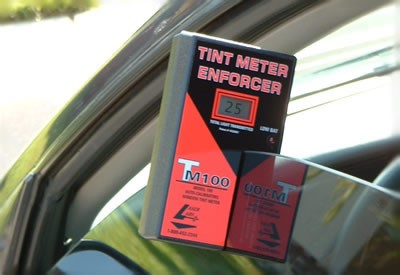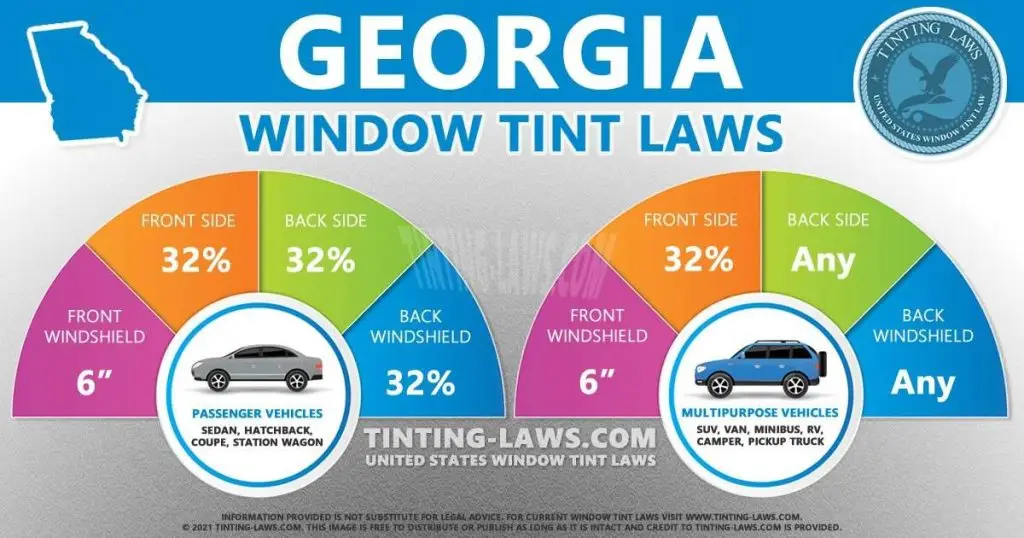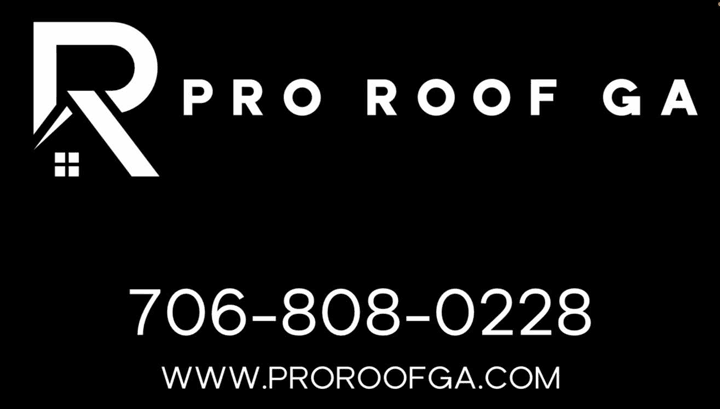
The tinting of vehicle windows is a common practice and many Georgia residents choose to do this for aesthetic appeal, passenger UV protection, vehicle interior protection, keeping a vehicle’s interior temperature cooler, and privacy from onlookers. Most Georgia residents know that laws exist governing how dark and where window tint can be placed. This has led to many conversations as to why there is even a law regarding window tint, as it does not seem to have any relation to vehicle safety and only serves as a method for law enforcement to write a citation. The reason why window tint has limits set forth by Georgia law is to prevent motor vehicle crashes caused by diminished visibility created by darker window tint. During a sunny day, this may not be cause for concern, but during days of cloudy, inclement weather, or during the evening and night times, heavily-tinted windows make it more difficult for a motorist to see clearly and this has resulted in preventable motor vehicle crashes. So, what exactly does Georgia law say in regard to window tint? The Official Code of Georgia Annotated provides the following information:
40-8-73.1. Tinting of Windows or Windshields.
(a) As used in this Code section, the term:
(1) “Light reflectance” means the ratio of the amount of total light that is reflected outward by a product or material to the amount of total light falling on the product or material.
(2) “Light transmission” means the ratio of the amount of total light, expressed in percentages, which is allowed to pass through a surface to the amount of light falling on the surface.
(3) “Manufacturer” means a person who produces or assembles a vehicle glass-coating material or who fabricates, laminates, or tempers a safety-glazing material, which material reduces light transmission.
(4) “Material” means any transparent product or substance which reduces light transmission.
(5) “Multipurpose passenger vehicle” means a motor vehicle designed to carry ten persons or less which is constructed on a truck chassis or with special features for occasional off-road operation.(b) Except as provided in this Code section, it shall be unlawful for any person to operate a motor vehicle in this state:
(1) Which has material and glazing applied or affixed to the front windshield, which material and glazing when so applied or affixed reduce light transmission through the windshield; or
(2) Which has material and glazing applied or affixed to the rear windshield or the side or door windows, which material and glazing when so applied or affixed reduce light transmission through the windshield or window to less than 32 percent, plus or minus 3 percent, or increase light reflectance to more than 20 percent.(c) The provisions of subsection (b) of this Code section shall not apply to:
(1) Adjustable sun visors which are mounted forward of the side windows and are not attached to the glass;
(2) Signs, stickers, or other matter which is displayed in a seven-inch square in the lower corner of the windshield farthest removed from the driver or signs, stickers, or other matter which is displayed in a five-inch square in the lower corner of the windshield nearest the driver;
(3) Direction, destination, or termination signs upon a passenger common carrier motor vehicle if the signs do not interfere with the driver’s clear view of approaching traffic;
(4) Any transparent item which is not red or amber in color which is placed on the uppermost six inches of the windshield;
(5) Any federal, state, or local sticker or certificate which is required by law to be placed on any windshield or window;
(6) The rear windshield or the side or door windows, except those windows to the right and left of the driver of:
(A) A multipurpose passenger vehicle;
(B) A school bus, any other bus used for public transportation, and any bus or van owned or leased by any religious or any nonprofit organization duly incorporated under the laws of this state;
(C) Any limousine owned or leased by a public or private entity; or
(D) Any other vehicle, the windows or windshields of which have been tinted or darkened before factory delivery or permitted by federal law or regulation;
(7) Any law enforcement vehicle;
(8) Any vehicle that displays a valid special license plate issued to a government official under Code Section 40-2-61, 40-2-63, or 40-2-64;
(9) Any vehicle owned or operated by the state or a political subdivision thereof and that displays a valid license plate issued pursuant to Code Section 40-2-37; or
(10) Any vehicle operated in the course of business by a person licensed or registered under Chapter 38 of Title 43, relating to private detective and private security businesses.(d) The Department of Public Safety may, upon application from a person required for medical reasons to be shielded from the direct rays of the sun and only if such application is supported by written attestation of such fact from a person licensed to practice medicine under Chapter 34 of Title 43 or a person certified as an optometrist under Chapter 30 of Title 43, issue an exemption from the provisions of this Code section for any motor vehicle owned by such person or in which such person is a habitual passenger. The exemption shall be issued with such conditions and limitations as may be prescribed by the Department of Public Safety.(e) No person shall install any material upon the windshields or windows of any motor vehicle, the installation of which would result in a reduction of light transmission or an increase in light reflectance in violation of subsection (b) of this Code section.(f) Notwithstanding any other provision of this Code section, commercial motor vehicles operated in this state are subject to the specifications of or limitations relating to windshield or window glazing or the application of light reducing or reflectance material to the windshield or windows as provided for in the federal motor carrier safety regulations contained in 49 C.F.R. 393.60 and adopted by the commissioner of public safety pursuant to Code Section 40-1-8.(g) The Department of Public Safety is authorized to promulgate such rules and regulations as may be necessary to carry out the provisions of this Code section.(h) Any person who violates subsection (b) or (e) of this Code section shall be guilty of a misdemeanor. So, what does any of this mean for the majority of Georgia vehicle owners? First, understand that under Georgia law, passenger cars, such as sedans and coupes, are categorized as one type of vehicle, whereas, a multipurpose passenger vehicle built on a truck chassis (SUV’s, pick-ups) are considered a different type of vehicle. No vehicles in either category can have any type of glazing or tinting material on the entirety of the front windshield. However, it is lawful to have a transparent covering of no more than six inches from the top of the front windshield and downwards (to assist with bright sunlight while operating a motor vehicle), as long as this covering is not red or amber in color. On both passenger cars and multipurpose passenger vehicles, the front driver and front passenger side windows cannot allow less than 32% light transmission or more than 20% light reflectance. The state of Georgia has allowed a +/- of 3% for the 32% light transmission requirement to account for law enforcement instrument accuracy.
Things begin to differ when we discuss the rear passenger windows. A passenger car must still meet the requirement of 32% (+/- 3%) light transmission or no more than 20% light reflectance on the rear passenger widows, which is the same for both the front driver and passenger windows as discussed. Multipurpose passenger vehicles, such as SUV’s, crew and extend-cab pick-up trucks are exempt and can have those windows as dark as the vehicle owner wishes.
The rear windshield is also different for both types of vehicles, whereas, a passenger car, such as a sedan or coupe, can have no less than 32% (+/- 3%) light transmission and no more than 20% light reflectance, but a multipurpose passenger vehicle (SUV’s and pickup-trucks (to include single-cab pick-ups)) can have window tint as dark as the vehicle owner desires on the rear-windshield.
The following graphic can be used for a visual representation of what is required by Georgia law regarding window tint. If there are any questions on the legality of your vehicle’s window tint, don’t be afraid to contact your local law enforcement agency, who can answer any questions you may have.



Bulloch Public Safety
05/02/2024 Booking Report for Bulloch County

Bulloch Public Safety
04/09/2024 Booking Report for Bulloch County

Bulloch Public Safety
04/08/2024 Booking Report for Bulloch County

Bulloch Public Safety
04/22/2024 Booking Report for Bulloch County

Bulloch Public Safety
04/15/2024 Booking Report for Bulloch County

Bulloch Public Safety
04/10/2024 Booking Report for Bulloch County







